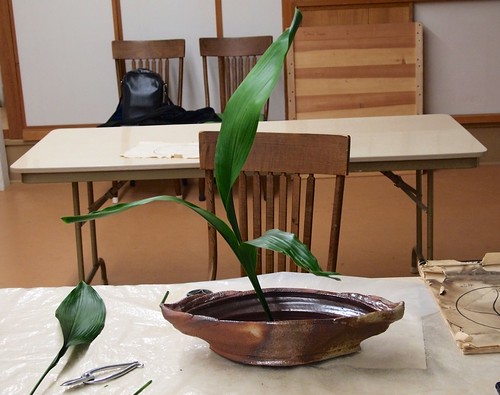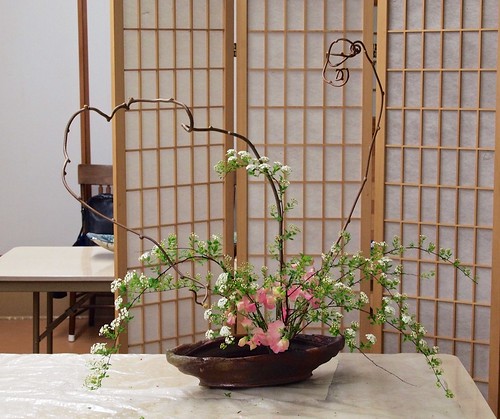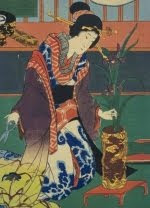Seika shape using Shippo fixing.
Aspidistra.
While I was in Portland I also contacted my FaceBook friend David Komeiji. He is the head of the Saga Goryu School of ikebana in Portland. The Saga Goryu School has it's headquarters in the Daikakuji Temple in Kyoto and is closely related to Shingon Buddhism.
After a very pleasant pot luck meal with mostly Japanese dishes we started working. While the group prepared for an upcoming demonstration I got the opportunity to try out working with a Shippo, a traditional tool used instead of a Kenzan. I have never tried this before so that was a real treat. The Shippo invites to a more slanting placement and you have to work more in accordance with the balance of the materials. Small pieces of the stem are used to fix the stem in the wright position. I tried a simple Seika form arranged with three Aspidistra leaves. David also demonstrated how to make an Inoribana (prayer flowers) which is a newer style developed by the Saga Goryu School.
The container is a wood fired ceramic bowl that I bought from the Portland based ceramicist Chris Baskin who came to deliver a selection of containers for the demonstration. He had made some really stunning big pieces that I was considering buying. I realized in time though that it would have been too unpractical to carry them around all the way back to Norway.
David then asked me to make a freestyle arrangement, still with a Shippo, but in the Sogetsu style. This was also quite challenging, but I like the result and the process of working with it. It's a bit like working with Nageire, you get more in contact with the branches than when you're using a Kenzan.
David's response from a Saga perspective was that it was good that the arrangement fits into a square shape and that the branches goes in all direction. With my Sogetsu approach my attempt was more in the direction of creating open spaces and clear lines, using curved lines in a triangular shape.
If you read Japanese you'll find more information on the official website of the Saga Goryu School.
Aspidistra.
While I was in Portland I also contacted my FaceBook friend David Komeiji. He is the head of the Saga Goryu School of ikebana in Portland. The Saga Goryu School has it's headquarters in the Daikakuji Temple in Kyoto and is closely related to Shingon Buddhism.
After a very pleasant pot luck meal with mostly Japanese dishes we started working. While the group prepared for an upcoming demonstration I got the opportunity to try out working with a Shippo, a traditional tool used instead of a Kenzan. I have never tried this before so that was a real treat. The Shippo invites to a more slanting placement and you have to work more in accordance with the balance of the materials. Small pieces of the stem are used to fix the stem in the wright position. I tried a simple Seika form arranged with three Aspidistra leaves. David also demonstrated how to make an Inoribana (prayer flowers) which is a newer style developed by the Saga Goryu School.
The container is a wood fired ceramic bowl that I bought from the Portland based ceramicist Chris Baskin who came to deliver a selection of containers for the demonstration. He had made some really stunning big pieces that I was considering buying. I realized in time though that it would have been too unpractical to carry them around all the way back to Norway.
David then asked me to make a freestyle arrangement, still with a Shippo, but in the Sogetsu style. This was also quite challenging, but I like the result and the process of working with it. It's a bit like working with Nageire, you get more in contact with the branches than when you're using a Kenzan.
David's response from a Saga perspective was that it was good that the arrangement fits into a square shape and that the branches goes in all direction. With my Sogetsu approach my attempt was more in the direction of creating open spaces and clear lines, using curved lines in a triangular shape.
Freestyle spring arrangement, using a Shippo fixture.
Kiwi vine, Spirea and Moncs cress.
Kiwi vine, Spirea and Moncs cress.
If you read Japanese you'll find more information on the official website of the Saga Goryu School.















No comments:
Post a Comment